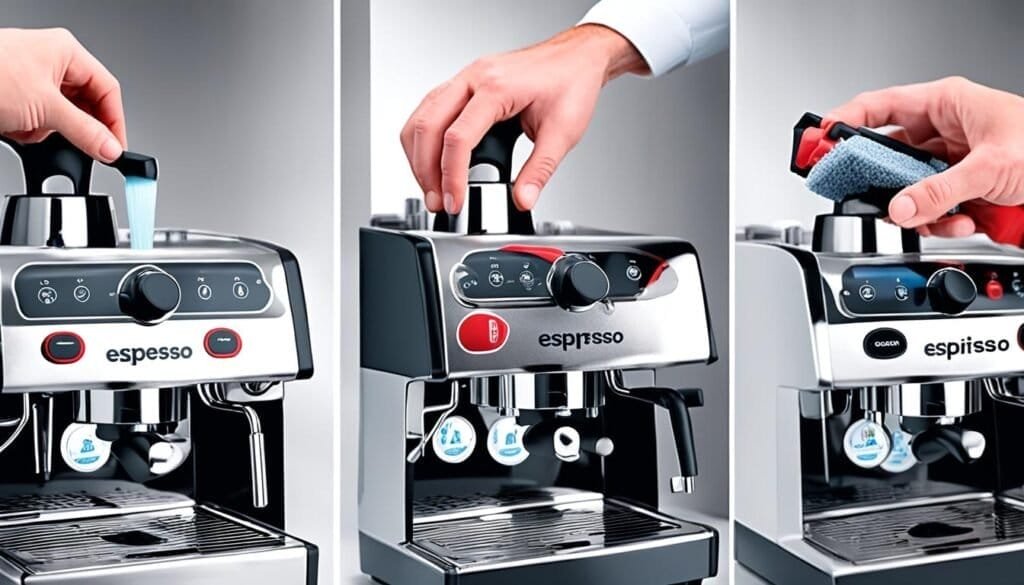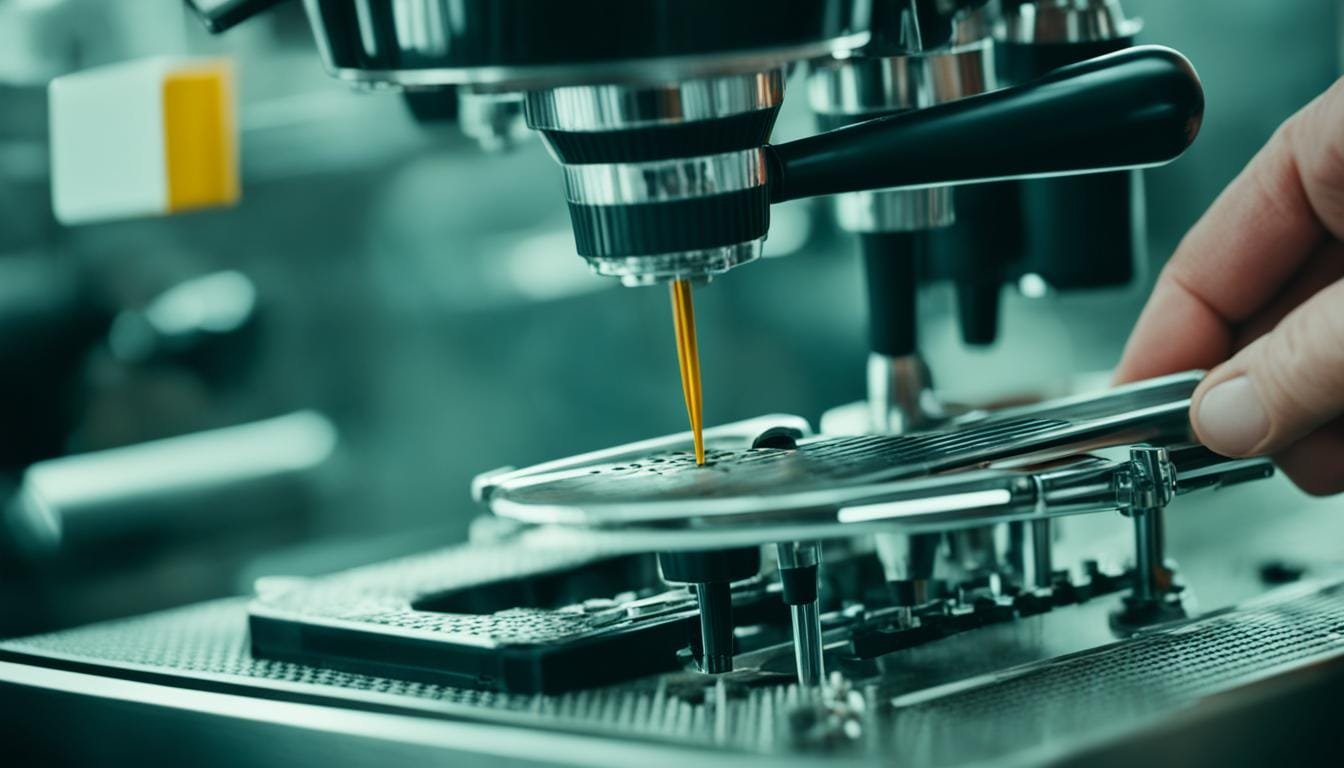Did you know that neglecting proper maintenance can significantly reduce the lifespan of your espresso machine? In fact, studies show that machines that are not regularly cleaned and maintained can have a lifespan that is up to 50% shorter than those that receive proper care. So if you want your espresso equipment to last and consistently deliver the perfect cup of coffee, it’s essential to follow advanced espresso machine maintenance tips.
Key Takeaways:
- Regular maintenance is crucial for the performance and longevity of your espresso machine.
- Cleaning and descaling prevent the buildup of coffee oils, residue, and limescale.
- Essential tasks include cleaning the drip tray, dreg drawer, steam wand, and regularly descaling.
- Semi-annual and annual maintenance tasks involve thorough cleaning, parts replacement, and water softening system checks.
- Understanding common espresso machine issues and troubleshooting techniques is important for quick resolution.
Why Cleaning Your Espresso Machine is Important
Regular cleaning of your espresso machine is crucial for maintaining the quality of your coffee and the reliability of your machine. By implementing proper maintenance practices, you can enjoy delicious coffee and extend the lifespan of your equipment.
1. Enhanced Coffee Quality:
Regular cleaning prevents the accumulation of coffee oils and residue, ensuring that your coffee is free from bitter taste and unpleasant odor. By keeping your espresso machine clean, you can consistently brew high-quality coffee that delights your taste buds.
2. Hygiene:
Neglected espresso machines can become breeding grounds for harmful bacteria. Regular cleaning promotes hygiene and ensures that you’re brewing coffee in a clean and safe environment. By taking the time to clean your machine, you prioritize the health and well-being of yourself and your customers.
3. Reliable Machine Performance:
Clean and well-maintained espresso machines are less likely to experience clogs and malfunctions. Regular cleaning and descaling prevent the buildup of mineral deposits and other contaminants that can hinder the proper functioning of your machine. By keeping your machine clean, you can trust in its reliability and avoid unexpected breakdowns.
Remember, investing a small amount of time into cleaning your espresso machine has significant benefits for both the taste of your coffee and the longevity of your equipment.
| Benefits of Cleaning Your Espresso Machine | |
|---|---|
| Enhanced coffee quality | Avoids bitter taste and unpleasant odor |
| Hygienic coffee preparation | Prevents bacteria growth |
| Reliable machine performance | Avoids clogs and malfunctions |
Essential Cleaning and Maintenance Tasks
To keep your espresso machine operating at its best, it’s crucial to perform regular cleaning and maintenance tasks. By following these essential steps, you can ensure the longevity and performance of your equipment. Here are the key tasks you should prioritize:
1. Drip Tray and Dreg Drawer Cleaning
The drip tray and dreg drawer collect excess coffee and spent grounds, so it’s important to clean them regularly. Empty and clean the drip tray daily to prevent spills and maintain hygiene. Similarly, empty and rinse the dreg drawer to avoid any buildup which can affect the machine’s overall performance.
2. Steam Wand and Milk System Maintenance
After each use, clean the steam wand and milk components to prevent milk residue buildup. Wipe the steam wand with a damp cloth and purge any remaining milk. For thorough cleaning, consider using a suitable cleanser or follow the manufacturer’s instructions. Regularly scheduled cleaning will ensure optimal functioning and maintain the quality of steamed milk.
3. Regular Descaling
Descaling is a critical maintenance task that removes limescale buildup from the machine’s internal components. Follow the manufacturer’s guidelines to determine the appropriate descaling frequency. Use a descaling solution specifically designed for espresso machines to ensure effective descaling without causing any damage. By regularly descaling, you can prevent clogs and maintain efficient operation.
4. Weekly Brew Unit Cleaning
It’s essential to clean the brew unit at least once a week to remove coffee grounds and oils. Refer to the manufacturer’s instructions for specific steps on cleaning the brew unit. This routine maintenance task ensures the quality of your coffee by preventing residue buildup and maintaining consistent flavor extraction.

Ensure to follow the appropriate safety precautions and use recommended cleaning products when performing these tasks. By staying on top of these essential cleaning and maintenance routines, you can maximize the lifespan and performance of your espresso machine, ensuring a consistently enjoyable coffee experience.
Semi-Annual and Annual Maintenance Tips
Proper maintenance of your espresso machine goes beyond regular cleaning. Semi-annual and annual maintenance tasks are essential to ensure optimal functionality and prolong the lifespan of your equipment. By incorporating these tasks into your maintenance routine, you can continue to enjoy the perfect cup of coffee every time.
Grinder and Steam Wand Cleaning
Regular cleaning of the grinder and steam wand is crucial to maintain the quality and consistency of your espresso shots. Coffee residue can build up over time, affecting the flavor and aroma of your brew. To prevent this, it’s recommended to clean the grinder and steam wand thoroughly at least twice a year. Refer to your machine’s manual for specific instructions on cleaning these components.
Water Softening System Check
The water softening system in your espresso machine helps prevent scale buildup and ensures the longevity of your equipment. As part of your annual maintenance, it’s important to check and replace the water softening system filter. This will help preserve the water quality and prevent any potential damage caused by mineral deposits.
Parts Replacement
Inspecting and replacing critical components is a crucial part of annual maintenance. During this time, it’s recommended to check and replace worn-out parts such as portafilter gaskets and screens. Additionally, cleaning the drain box and line helps maintain proper drainage and prevents any blockages that may affect the performance of your machine.
Regular maintenance tasks, both semi-annual and annual, can help prevent machine breakdowns and extend the lifespan of your espresso machine.
By following these semi-annual and annual maintenance tips, you can keep your espresso machine in top shape and ensure it continues to deliver exceptional coffee. Prioritizing the cleanliness and functionality of your equipment guarantees a consistent brewing experience and enhances the longevity of your beloved espresso machine.
| Maintenance Task | Frequency |
|---|---|
| Grinder and Steam Wand Cleaning | Semi-annually |
| Water Softening System Check | Annually |
| Parts Replacement | Annually |
Troubleshooting Common Espresso Machine Issues
Even with regular maintenance, espresso machines can sometimes encounter issues that affect their performance. However, understanding how to troubleshoot common problems can help you address them effectively and ensure uninterrupted coffee service.
Inconsistent Espresso Shots
One common issue that espresso machine users may face is inconsistent espresso shots. This can be attributed to several factors, including:
- Tamping variations: Inadequate or uneven tamping of coffee grounds can lead to inconsistent extraction and affect the taste of your espresso. Ensure that you apply the right amount of pressure and level the coffee bed evenly.
- Grind size issues: The size of the coffee grounds plays a crucial role in the extraction process. If the grind size is too fine or coarse, it can result in under-extraction or over-extraction, leading to inconsistent flavor profiles.
- Clogged filters: Over time, coffee particles can accumulate and clog the filters. This hinders the flow of water, affecting the extraction process. Regularly clean and replace the filters to maintain optimal performance.
Steam Wand Problems
Another common issue is related to the steam wand, especially for machines with milk frothing capabilities. Here are some potential causes for steam wand problems:
- Milk residue buildup: If you notice a decrease in steam pressure or blockages in the steam wand, milk residue may be the culprit. Clean the steam wand thoroughly after each use to prevent residue buildup and ensure proper frothing and steaming.
- Worn out or faulty parts: Over time, the steam wand may develop leaks or experience wear and tear. Check for any loose connections or damaged components and replace them if necessary.
Steam and Water Leaks
Steam and water leaks are not only inconvenient but can also indicate underlying issues with the machine. Here are some possible causes for steam and water leaks:
- Loose or damaged fittings: Inspect all the connections and fittings in your espresso machine. If you notice any loose or damaged parts, tighten or replace them accordingly to prevent leaks.
- Faulty valves: The valves within the espresso machine regulate the flow of steam and water. If these valves are faulty, they can cause leaks. Review the valve mechanisms and repair or replace them as needed.
By familiarizing yourself with these common espresso machine issues and their solutions, you can quickly troubleshoot and resolve any problems that arise. However, if you encounter persistent issues or are unsure about how to address them, it is always recommended to consult a professional technician.

Conclusion
Regular maintenance is vital for maximizing the performance and lifespan of your espresso machine. By adhering to proper cleaning and maintenance practices, you can prevent common issues like clogs, malfunctions, and scale buildup. Performing regular maintenance tasks, both on a weekly and periodic basis, will help ensure that your espresso machine continues to deliver consistently delicious coffee.
Additionally, promptly addressing any troubleshooting issues that arise can minimize downtime and ensure uninterrupted coffee service. By investing time and effort into advanced espresso machine maintenance, you not only enhance the reliability of your equipment but also maintain the quality of your coffee.
Remember, a well-maintained espresso machine is the key to obtaining optimal performance and extending the lifespan of your equipment. By prioritizing regular maintenance and promptly addressing any issues that may arise, you can enjoy the maximum performance, reliability, and longevity that your espresso machine has to offer.
FAQ
Why is regular cleaning of an espresso machine important?
Regular cleaning prevents the accumulation of coffee oils and residue that can affect the taste and odor of your coffee. It also promotes hygiene and prevents the growth of harmful bacteria. Additionally, it improves the reliability of your machine by preventing clogs and malfunctions.
What are some essential cleaning and maintenance tasks for an espresso machine?
Some essential tasks include cleaning the drip tray and dreg drawer, cleaning the steam wand or milk components after each use, descaling regularly to remove limescale, and cleaning the brew unit weekly to remove coffee grounds and oils.
Are there any maintenance tasks that should be performed semi-annually or annually?
Yes, some tasks should be done semi-annually or annually. These include thorough cleaning of the grinder and steam wand, checking and replacing the water softening system filter, inspecting and replacing critical components like gaskets and screens, and cleaning the drain box and line.
What are some common issues that may occur with an espresso machine?
Some common issues include inconsistent espresso shots (due to tamping variations, grind size issues, or clogged filters), steam wand problems (such as insufficient pressure or blockages), and steam and water leaks (due to loose or damaged fittings or faulty valves).




